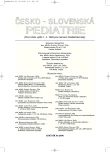-
Medical journals
- Career
Apolipoproteins in Cherokee Children and Adolescents
Authors: P. R. Blackett 1; W. Wang 2; E. Quintana 3; P. Alaupovic 4; E. T. Lee 5
Authors‘ workplace: Department of Pediatrics, University of Oklahoma Health Sciences Center, Oklahoma City, Oklahoma Center for American Indian Health Research, College of Public Health, University of Oklahoma Health 1; Sciences Center, Oklahoma City, Oklahoma 2; WW Hastings Indian Hospital, Tahlequah, Oklahoma 3; Oklahoma Medical Research Foundation, Oklahoma City, Oklahoma Center for American Indian Health Research, College of Public Health, University 4; of Oklahoma Health Sciences Center, Oklahoma City, Oklahoma 5
Published in: Čes-slov Pediat 2006; 61 (9): 477-483.
Category: Original Papers
Overview
Since American Indians are susceptible to type 2 diabetes and associated cardiovascular risk, we determined the prevalence of risk factors in relation to age so that the data might reveal early predictors and intervention targets. We studied 5–20 year-old Cherokee Indians, who are members of the largest Indian Nation in Oklahoma. When we studied those without diabetes, we found that apolipoprotein B, apoC-III bound to apoB and the apoB:A-I ratio increased in proportion to the fasting insulin resistance (HOMA-IR), whereas HDL-C, LpA-I and LpA-I:A-II decreased, particularly in boys during adolescence. Visceral fat measured as the waist circumference had a significant effect on the HDL lipoproteins and HDL-C. Lp(a) was lower than in other ethnic groups, but when elevated, the levels may compound cardiovascular risk.
Labels
Neonatology Paediatrics General practitioner for children and adolescents
Article was published inCzech-Slovak Pediatrics

2006 Issue 9-
All articles in this issue
- Apolipoproteins in Cherokee Children and Adolescents
- National Cholesterol Program in Children’s Population in Slovakia and Its Contribution
- Non-cholesterol Sterols in Healthy Children and Low Cholesterol Dietary Treatment of Children Suffering from Familial Hypercholesterolemia
- Dietary Habits of 9–10 Years Old Children from Pilsen City
- Primary Disorders of Lipid Metabolism in Children – Our Experience
- Food Supplements with Fish Oils – The Composition of Fatty Acids
- Does Artificial Suckling Nutrition Pose a Risk of Atherosclerosis at the Adult Age?
- Evaluation of Increased Levels of Neonatal Screening TSH in Slovakia
- What is New in the Diagnostics and Treatment of Arterial Hypertension in Children?
- Czech-Slovak Pediatrics
- Journal archive
- Current issue
- Online only
- About the journal
Most read in this issue- Primary Disorders of Lipid Metabolism in Children – Our Experience
- Does Artificial Suckling Nutrition Pose a Risk of Atherosclerosis at the Adult Age?
- Food Supplements with Fish Oils – The Composition of Fatty Acids
- National Cholesterol Program in Children’s Population in Slovakia and Its Contribution
Login#ADS_BOTTOM_SCRIPTS#Forgotten passwordEnter the email address that you registered with. We will send you instructions on how to set a new password.
- Career

